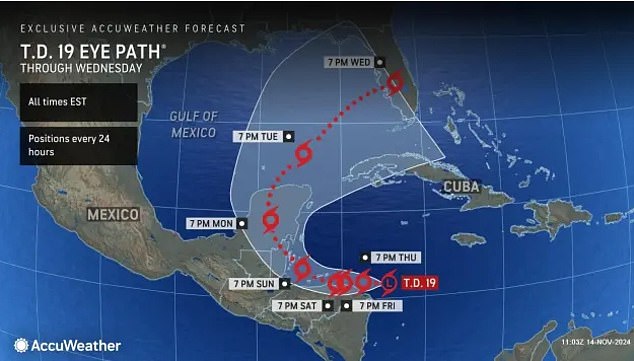‘Life-threatening’ warning issued in Caribbean as spaghetti model reveals storm Sara’s chance of hitting US
A life-threatening warning has been issued in the Caribbean as a storm gains strength and could set a path towards Florida.
The National Hurricane Center (NHC) issued an advisory Thursday saying Tropical Depression 19 is likely to develop into Tropical Storm Sara today, unleashing deadly flash flooding on Honduras throughout the weekend.
AccueWeather Meteorologists said there is a chance the system could quickly develop into a major hurricane before possibly making landfall on the west coast of Florida next Wednesday around 7 p.m. ET.
“But due to the proximity to land, rapid strengthening of a major hurricane now appears unlikely,” AccuWeather experts said.
And a new spaghetti model — so named because its lines resemble strands of pasta — revealed at least two possible paths this storm could take to the US.
If it becomes a hurricane, it will be named Hurricane Sara – the twelfth storm of the 2024 Atlantic hurricane season.
‘Should the current tropical depression intensify after it emerges over the Gulf of Mexico? Mexico and become a hurricane, it would be the fourth hurricane to hit Florida this season,” said AccuWeather Senior Meteorologist Dave Houk.
“If so, it will surpass the record of three landings in one season set in 2004.”
Tropical Depression 19 is currently barreling toward Honduras, and could head toward Florida once the country leaves the Caribbean, experts say
According to the 7 a.m. ET NHC update, Tropical Storm Sara is likely about 250 miles east of Isla Guanaja, Honduras, moving westward at 15 miles per hour.
A spaghetti model made by Follow the tropics shows the storm making landfall in northern Honduras before moving northeast through Belize, the northeastern corner of Guatemala and the southeastern tip of Mexico.
If the storm system doesn’t dissipate as it moves through Central America and southeastern Mexico, Floridians may have to brace for yet another storm impact, researchers said. AccuWeather.
“The track will likely be strongly influenced by the position of a high-pressure dome along the southern Atlantic coast of the United States and the speed of an approaching non-tropical storm and a trailing cold front,” meteorologists said.
This high-pressure dome and the cold front could send the storm into Central America or southeastern Mexico late this week, she added.
If potential Tropical Storm Sara barrels toward the Sunshine State, it will most likely impact the Florida Keys and the southern portion of the Florida Peninsula.
But the NHC has stated that “it is too early to determine what impacts the system could have on portions of the eastern Gulf of Mexico, including Florida, the Florida Keys and Cuba, by the middle of next week.”
Experts are still watching this system closely as it is expected to strengthen as it moves into Central America.

A spaghetti model shows the storm making landfall in northern Honduras before moving northeast through Belize, the northeastern corner of Guatemala and southeastern Mexico
AccuWeather Chief On-Air Meteorologist Bernie Rayno said, “And with the showers and thunderstorms developing a circulation, it probably won’t be much longer before the tropical depression develops into a tropical storm.”
That’s because “wind shear remains negligible in much of the Caribbean and waters are sufficiently warm,” he said, which will create optimal conditions for development.
The tropical depression, a cyclone with maximum sustained surface winds of 60 km per hour or less, is currently producing winds of 56 km per hour and could drop a total of 90 centimeters of rain in northern Honduras, according to the NHC.
While this area will see the most intense impacts, the rest of the country, as well as Belize, El Salvador, eastern Guatemala and western Nicaragua, could receive a total of 18 inches of rain locally early next week.

AccuWeather meteorologists predict the storm could hit the west coast of Florida on November 20 at 7:00 PM ET
‘This produces areas of flash flooding, perhaps significantly, along with the potential of mudslides,” the NHC said.
As it moves over land, the storm may lose wind intensity before turning toward the Gulf of Mexico and may not have time to strengthen into a hurricane before approaching Florida, according to AccuWeather.
Therefore, the chance of this storm becoming Hurricane Sara is unlikely, but there is still a small chance.
‘Must be the [rainstorm] If a hurricane were to become a hurricane, it would be the twelfth of the season, which is a testament to the strong nature of the season, with the historical average being seven hurricanes,” said Alex DaSilva, AccuWeather’s chief hurricane expert.
It is rare for Atlantic hurricanes to hit the US in November, the last month of the hurricane season.
Of the 287 hurricanes that have made landfall on the U.S. mainland since 1851, only four made landfall in November, according to NOAA data.
Three made landfall in Florida and one in North Carolina.
